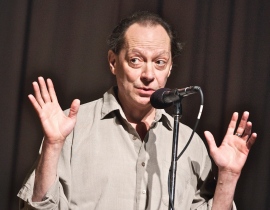
“She taught me to reread our Creole city’s two spaces: the historical center living on the new demands of consumption; the suburban crowns of grassroots occupations, rich with the depth of our stories. Humanity throbs between these two places. In the center, memory subsides in the face of renovation … here on the outskirts, one survives on memory.”
—Patrick Chamoiseau, Texaco, p. 170.
In the novel Texaco, an old woman named Marie-Sophie Laborieux tells a young urban planner the story of her neighborhood, a slum named after a nearby oil refinery on the island of Martinique. The urban planner sees the slum as place of chaos, disorder, violence, sex, and death. The slum grew up around the refinery because it provided jobs for the poor and uneducated who could not afford to live in the city, Fort-de-France, which was the capital and the center of everything civilized on the island.

Modern-day Fort-de-France
“In its old heart: a clear, regulated, normalized order. Around it: a boiling, indecipherable, impossible crown, buried under misery and History’s obscured burdens. If the Creole city had at its disposal only the order of the center, it would have died. It needs the chaos of its fringes. Beauty replete with horror, order set in disorder.”
—Texaco, p. 184
Marie-Sophie tells her story on the precipice of annihilation, a Caribbean Scheherazade to the urban planner from Fort-de-France’s development agency who has come to study Texaco in preparation for the slum’s demolition. The story begins with Marie-Sophie’s father, Esternome, born into slavery and freed as a young man. This is not the story you find in books. It’s the kind of story that people tell one another at dinner and around bonfires.

Refugees from the damage caused by the eruption of Mt. Pelée in 1902
These are the stories that Chamoiseau, a noted anthropologist, has made it his life’s work to understand—along the way publishing both ethnographic studies and fiction based in Martinique and the cultures of the Caribbean. Chamoiseau’s work on either side of the fiction/non-fiction divide is equally celebrated as it exposes the voices of those who live “beneath history,” as Chamoiseau puts it. These are the stories that give us a different way to see the non-self-evident goodness of what we normally call progress or modernity.

A hillside shantytown in Fort-de-France
Progress, in a word, means the destruction of everything Marie-Sophie will tell the urban planner in the course of the novel’s 400-or so pages. While destruction itself is not always and everywhere a horrible thing, in no place in this story is it clear why this destruction or progress is necessary. The novel’s real purpose is given away in the urban planner’s name, Oiseau de Cham, the author’s barely disguised fictionalized self complicit in the dismantling of the culture and people—his own—that he has faithfully catalogued in all his writing. In recording these stories, he annihilates them even as he preserves them.
. . . I did my best to write down this mythic Texaco, realizing how much my writing betrayed the real, revealing nothing of my Source’s breath, nor even the destiny of her legend . . . I wanted it to be sung somewhere, in the ears of future generations, that we had fought with City, not to conquer it (it was City that gobbled us), but to conquer ourselves in the Creole unsaid which we had to name—in ourselves and for ourselves—until we came into our own.
—Texaco, p. 390
In Texaco, Mr. Chamoiseau’s two writerly lives meet. It is the chronicle of his life swept up by the grand rip currents of history.
Notes and Credits
This is the first of 3 posts in a longer essay on the concepts of “progress” and “globalization.” I examine these issues through modern literature: Chamoiseau’s Texaco here, and then Robert Bolaño’s The Savage Detectives and 2666.
I read Texaco while I was editing the book, Globalizations and Social Movements with Mayer Zald and Michael Kennedy. I was deeply moved by the book and wound up quoting Texaco twice in the introductory chapter. In Chamoiseau’s writing, I saw echoes of my own experiences gathering oral histories in Belém, Brazil througout 1992 and 1993, yet without the same remorse Chamoiseau/Oiseau de Cham felt. For the people of Belém were not my own, even if my Belemense friends and I sometimes felt otherwise.
There, I worked in neighborhoods of all social classes, but I especially loved my time in the neighborhoods of Bom Futuro and Aurá. These areas would be called favelas elsewhere in Brazil, or “slums” or “shantytowns” in English. The residents, however, resoundingly favored the term invasão, meaning land invasion, because it described their own action to take the land in a politically motivated context.
One of the eye-opening moments in my work came in Aurá when Dona Walda—after telling me her stories for over 2 hours one morning—looked squarely into my eyes, took my hand in hers, and said, “We are not important, but in our own lives, we are important.” I think that statement will be the germ of another post, after this series is done.
Photographs:
[1] The photo of the oil refinery was taken by the author at Baby Beach, Aruba, in February 2013. We were on vacation there and I couldn’t help but think of Texaco when we stopped there for a swim. The beach, which is opposite this view of the refinery, is very nice. Baby Beach was created as a shallow swimming lagoon for the Aruba Esso Club. The refinery is currently owned and operated by the Valero Energy Corporation.
[2] The photograph of the modern city of Fort-de-France is from Panoramio and was accessed through Google Earth. The photo was taken by Panoramia user FloetGilou.
[3] The next photograph is of refugees fleeing the 1902 eruption of Mt. Pelée, which devastated the surrounding area and killed dozens of people. The picture is in the public domain and was uploaded to Wikimedia Commons by William Herman Rau.
[4] The photograph of a hillside shantytown, probably much like Texaco, is from the web version of a brochure for the international conference called “The Changing World of Coastal, Island and Tropical Tourism,” which was held in Martinique in January 2011. I would have liked to put this photograph in the place where the modern Fort-de-France photo is, but I couldn’t manipulate the size of the photo due to its original file properties.

















